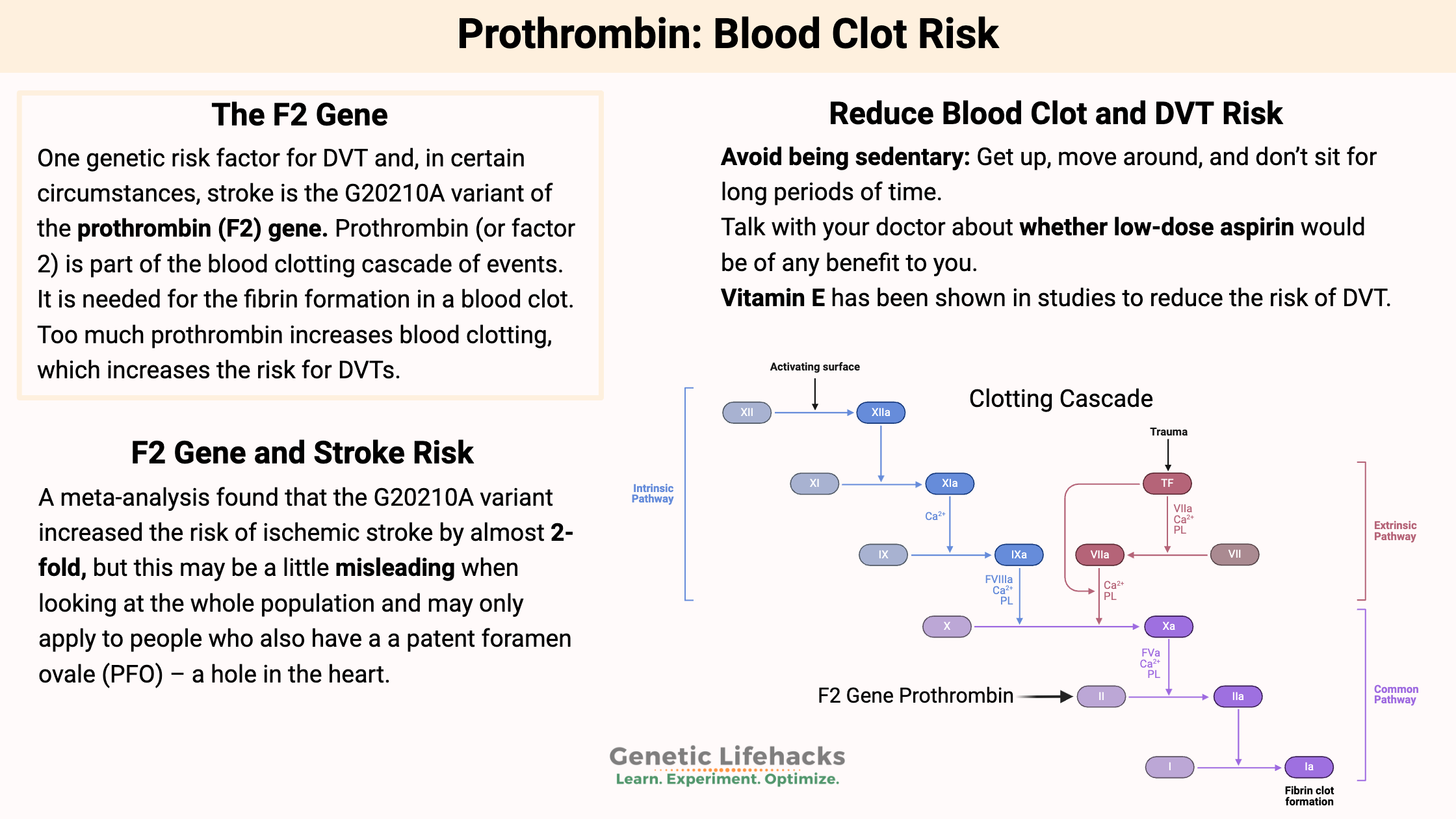Scenario: You wake up one morning with a pain in your leg, trying to think back as to what you did the previous day to cause it… Then you notice that your leg is a little swollen and warm. Oh no, these could be the signs of a blood clot in your leg![ref]
One hereditary basis for an elevated risk of clots, prothrombin, is explored in this article. I’ll review the science and then show you what to look for in your genetic raw data. <b>Members</b> will see their genotype report below and the solutions in the Lifehacks section. <a href=”https://www.geneticlifehacks.com/membership/”>Consider joining today</a>.
What is Deep Venous Thrombosis (DVT)?
Deep vein thrombosis (DVT) occurs when you have a blood clot in one of the larger veins of your arm or leg. This blood clot can then break free and travel to the lungs (pulmonary embolism). A blood clot that blocks the blood supply to the lungs is, obviously, a very serious problem.
Blood clots can occur for a variety of reasons, such as injury, surgery, and certain medications (chemo, birth control, etc.). Blood clots can also occur when sitting too long, if the blood pools in the lower parts of your legs.
Venous thromboembolism occurs at a rate of 1 in 1,000 adults per year in the US. Venous thromboembolism is a term that encompasses both deep venous thrombosis and pulmonary embolism.[ref]
At the top of the list of DVT risk factors is always ‘a family history’ of blood clots. Genetics (heredity) is a large factor in who is more likely to get a blood clot.
Where else does blood clotting become an issue? Strokes caused by ischemia. This is a form of stroke that results in a shortage of oxygen due to a blockage in the artery, which is usually caused by a blood clot.
The F2 (prothrombin) gene and blood clots:
One genetic risk factor for DVT and, in certain circumstances, stroke is the G20210A variant of the prothrombin (F2) gene.
Prothrombin (or factor 2) is part of the blood clotting cascade of events. It is needed for the fibrin formation in a blood clot. Too much prothrombin increases blood clotting, which increases the risk of DVTs.[ref]
About 2% of Caucasians carry the G20210A variant, which is much less common in Asians, Africans, and Native Americans.
Increased clot risk from prothrombin variant:
A meta-analysis found that carrying the G20210A variant increased the risk of thromboembolism by 2.6 to 4.4-fold (depending on the location of the clot). It is rare to carry two copies of the G20210A, but the clot risk for people with two copies is much higher. The risk of DVT is also greatly increased in carriers of both G20210A and the factor V Leiden variant.[ref]
Related article: check your factor V genetic variants
The studies on stroke risk for the F2 G20210A variant give various results as to the increase in risk.
Increased stroke risk from prothrombin variant:
A meta-analysis found that the G20210A variant increased the risk of ischemic stroke by almost 2-fold, but this may be a little misleading when looking at the whole population. For people with a patent foramen ovale (PFO) – a hole in the heart – the risk of stroke for those with the G20210A variant was almost 4X.[ref] About 25% of the population has a PFO (hole in the heart), but most people don’t even know that they have it.[ref] So, a lot of the increase in risk for stroke from the G20210A variant may only be in people with a patent foramen ovale.
Increased miscarriage risk from prothrombin variant:
The G20210A variant also increases the risk of miscarriage (due to a blood clot in the placenta)[ref] and increases the risk of DVT in pregnancy a little.[ref]
Other, more common variants in the F2 gene are also linked to a slightly increased risk of clots.
Factor 2 Genotype Report:
Lifehacks:
Suggestions to reduce your blood clot and DVT risk:
Avoid being sedentary:
Get up, move around, and don’t sit for long periods of time.
Newer activity monitors — like the Fitbit or Oura ring – can detect when you have been sitting for an hour and prompt you to get up and move. Or you can just set your timer on your phone to give you an alert every hour or so to remind you.
Moving while sitting:
Stuck on a plane or in a meeting? Get your legs moving as much as possible — do ankle circles or just raise your heels up and down.
Talk with your doctor about aspirin and vitamin E:
Talk with your doctor about whether low-dose aspirin would be of any benefit to you.
The research on the topic shows various results depending on the circumstances (pregnancy, age, previous DVT, etc.). A long-term clinical trial found that low-dose aspirin had little effect (~5% reduction in risk) for women over age 45.[ref]
Vitamin E has been shown in studies to reduce the risk of DVT.[ref]
For some people, vitamin E may not be the right option. Read these two articles first: Vitamin E and increased cancer risk. & Vitamin E and Inflammation.
Related Articles and Topics:
Factor V Leiden: Blood Clot Risk
The factor V Leiden genetic mutation significantly increases the lifetime risk of blood clots. Check your genetic data to see if you carry this mutation – and then learn to recognize the symptoms of blood clots.
AGTR1: Genetic Variants that Cause High Blood pressure
There are several causes of high blood pressure. Genetic variants in the AGTR1 gene are strongly linked with blood pressure — and there are specific lifestyle changes that should work to change your blood pressure if you carry the variants.

